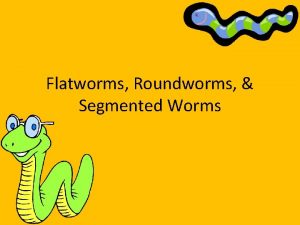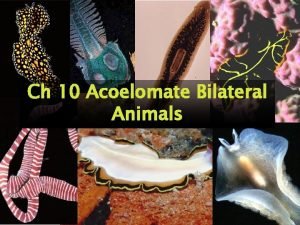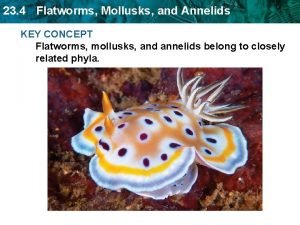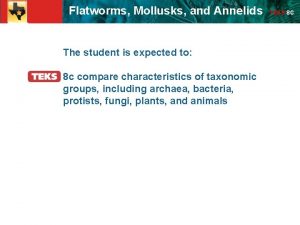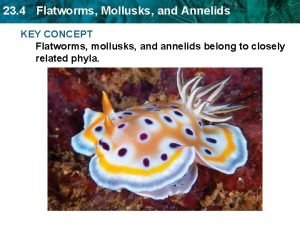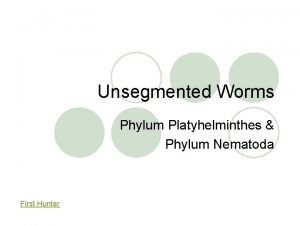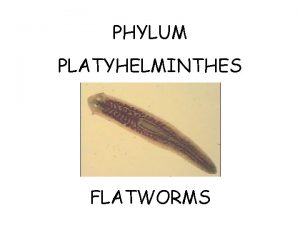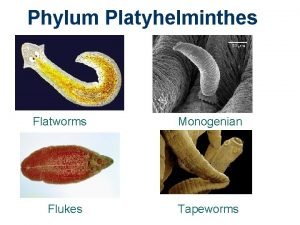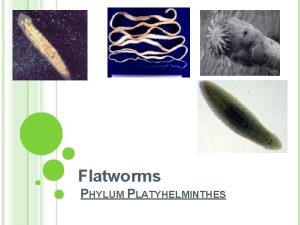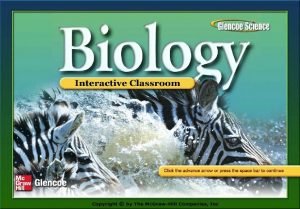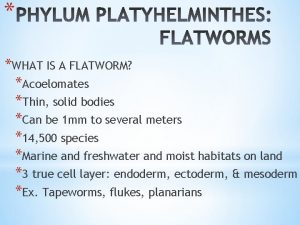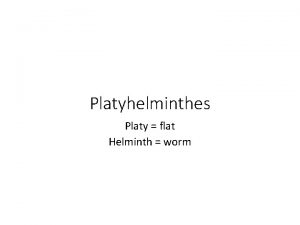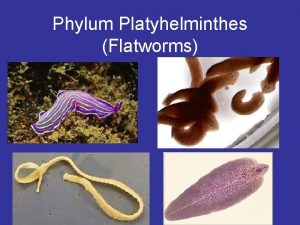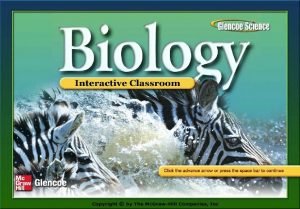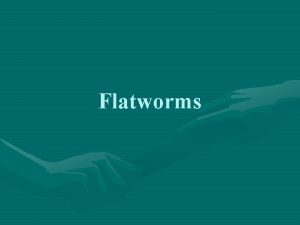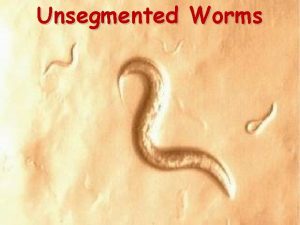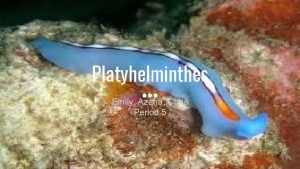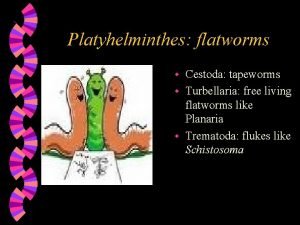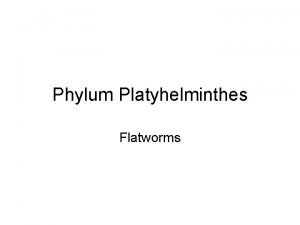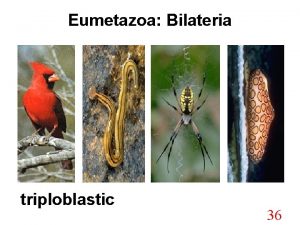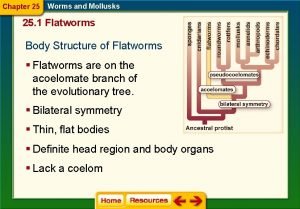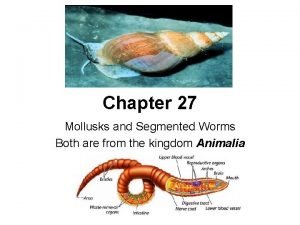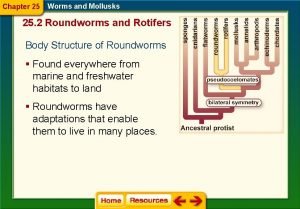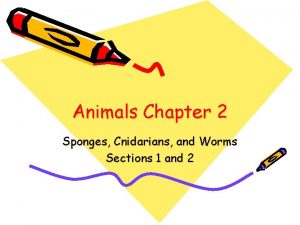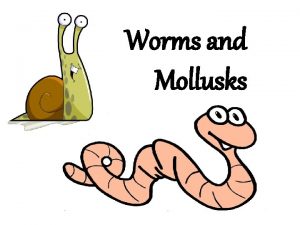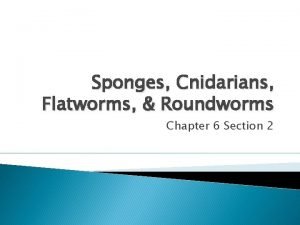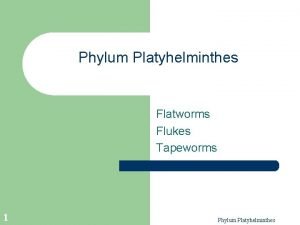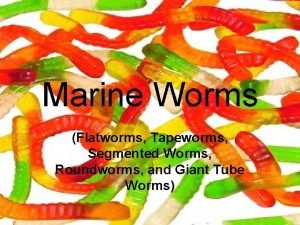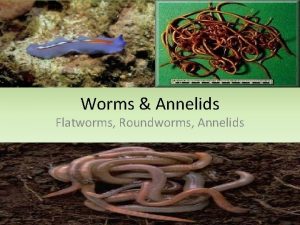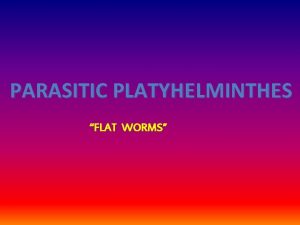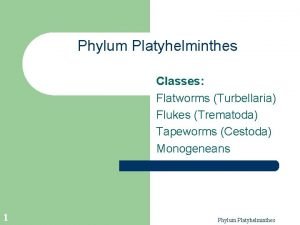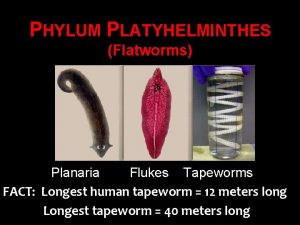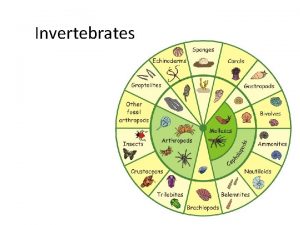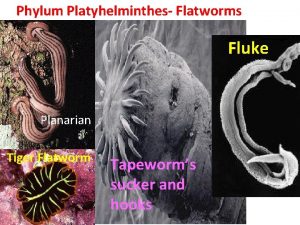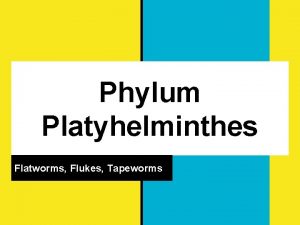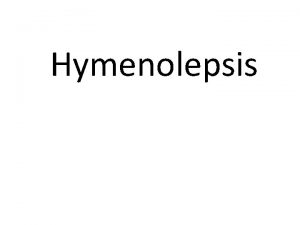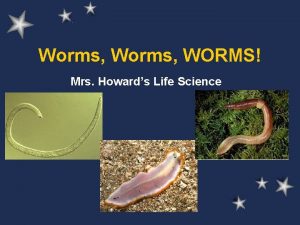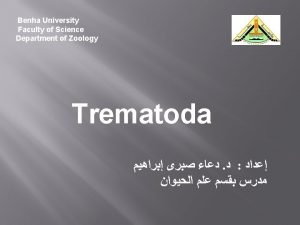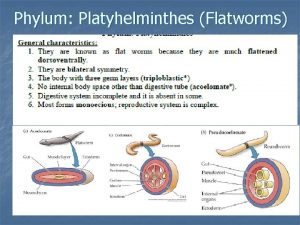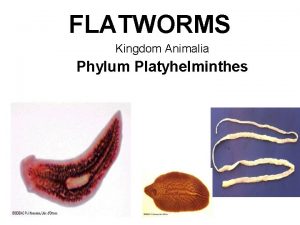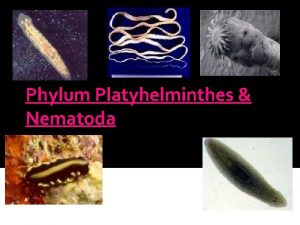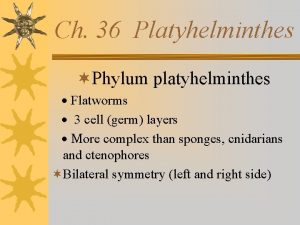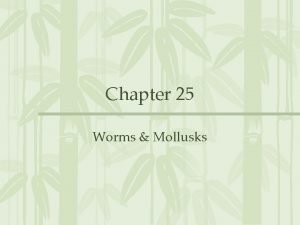WORMS Platyhelminthes Notes Flatworms and Tapeworms What is































- Slides: 31

WORMS Platyhelminthes Notes Flatworms and Tapeworms


What is a flatworm? • Phylum Platyhelminthes • The least complex worms belong to this phylum. • These flatworms are acoelomates (which means they have no body cavities) and they have bilateral symmetry. • They have thin, solid bodies. • They live in oceans and freshwater and also in moist habitats on land. • The most well-known members of this phylum are the parasitic tapeworms and flukes, which cause disease in other animals, including humans. • The most commonly studied flatworms are planarians.

A. Nervous System (planarian) • Most of the nervous system is located in the head.

Nervous System • Some flatworms have a nerve net, and others have the beginnings of a central nervous system.

Nervous System • The planarian nervous system includes two nerve cords that run the length of the body. • It also includes eyespots that can detect the presence or absence of light.

Nervous System • It also has sensor cells that can detect chemicals and movement in the water. • At the anterior end of the nerve cord is a small swelling called a ganglion. • This receives messages from the eyespots and sensory pits and communicates to the rest of the body.

B. Reproduction (planarian) • Planarians are hermaphrodites. • During sexual reproduction, individual planarians exchange sperm, which travel along tubes to reach the eggs. • Fertilization occurs internally. • The zygotes are released in capsules into the water, where they hatch into tiny planarians. • Asexual reproduction involves regeneration, which is the replacement or regrowth of missing body parts.


C. Feeding/Digestion (planarian) • Planarians feed on dead or slow-moving organisms. • It extends a tube-like, muscular organ called a pharynx out of its mouth. • Enzymes released by this structure begin digesting the food outside the planarian’s body. • Food particles are sucked into the digestive tract, where they are broken up.


D. Feeding/Digestion (parasitic flatworms) • These flatworms are adapted to obtaining nutrients from inside the bodies of one or two hosts. • These parasites have mouthparts with hooks that keep the worm firmly attached inside the host. • Because they are surrounded by nutrients, they do not need to move to find food.

E. Tapeworm Bodies • The body of a tapeworm is made up of a knob-shaped head called a scolex. • The body also has detachable, individual sections called proglottids. • This section contains muscles, nerves, flame cells, and male/female reproductive organs. • The flame cells help remove excess water. • Each proglottid can contain up to 100, 000 eggs. • Some adult tapeworms that live in animal intestines can be more than 10 meters in length.





F. Fluke Life Cycle • A fluke is a parasitic flatworm that spends part of its life in internal organs of a vertebrate (ex. Human, sheep). • It feeds on cells, blood, and other fluids from the host.

Fluke Life Cycle • Flukes have complex life cycles that can include one, two, or more hosts.

Flukes • Blood flukes from the genus Schistosoma cause a disease in humans called schistosomiasis. • This is common in countries where rice is grown. • Farmers have to work in standing water in rice fields during planting and harvesting.

Classes in Phylum Platyhelminthes • Class Turbellaria: planarians – Convoluta – Macrostomum lineare – Stylochus zebra

Class Turbellaria • Convoluta

Class Turbellaria • Macrostomum lineare

Class Turbellaria • Stylochus zebra

Phylum Platyhelminthes • Class Monogenea – Gyrodactylus elegans – Diplozoan paradoxum

Class Monogenea • Gyrodactylus elegans

Class Monogenea • Diplozoan paradoxum

Class Monogenea • Polystoma

Phylum Platyhelminthes • Class Trematoda – Schistosoma mansoni – Non-schistosomes

Class Trematoda • Schistosoma mansoni

Phylum Platyhelminthes • Class Cestoidea
 Are flatworms segmented
Are flatworms segmented Acoelomate bilateral animals
Acoelomate bilateral animals Section 4 flatworms mollusks and annelids
Section 4 flatworms mollusks and annelids Section 4 flatworms mollusks and annelids
Section 4 flatworms mollusks and annelids Section 4 flatworms mollusks and annelids
Section 4 flatworms mollusks and annelids Unsegmented worms
Unsegmented worms Platyhelminthes vs nematoda
Platyhelminthes vs nematoda Phylum
Phylum Flatworms
Flatworms The simplest animals to have body symmetry are
The simplest animals to have body symmetry are Chapter 27 worms and mollusks
Chapter 27 worms and mollusks Chapter 25 section 1 flatworms
Chapter 25 section 1 flatworms Are flatworms acoelomates
Are flatworms acoelomates How do flatworms move
How do flatworms move Www.youtube.com
Www.youtube.com Chapter 25 section 1 flatworms answer key
Chapter 25 section 1 flatworms answer key Flatworm bilateral symmetry
Flatworm bilateral symmetry Flatworm body plan
Flatworm body plan Platyhelminthes
Platyhelminthes Turbelaria
Turbelaria Marine flatworm symmetry
Marine flatworm symmetry Tremotoda
Tremotoda Section 27-1 flatworms
Section 27-1 flatworms Eumetazoa examples
Eumetazoa examples Chapter 25 section 1 flatworms
Chapter 25 section 1 flatworms Cube wisc
Cube wisc Chapter 27 mollusks and segmented worms answer key
Chapter 27 mollusks and segmented worms answer key Chapter 25 section 2 roundworms and rotifers answers
Chapter 25 section 2 roundworms and rotifers answers Sponges cnidarians and worms
Sponges cnidarians and worms Characteristics of flat worms
Characteristics of flat worms Fat worms waiting on a dawn bright lawn
Fat worms waiting on a dawn bright lawn Chapter 26 sponges and cnidarians answer key
Chapter 26 sponges and cnidarians answer key
